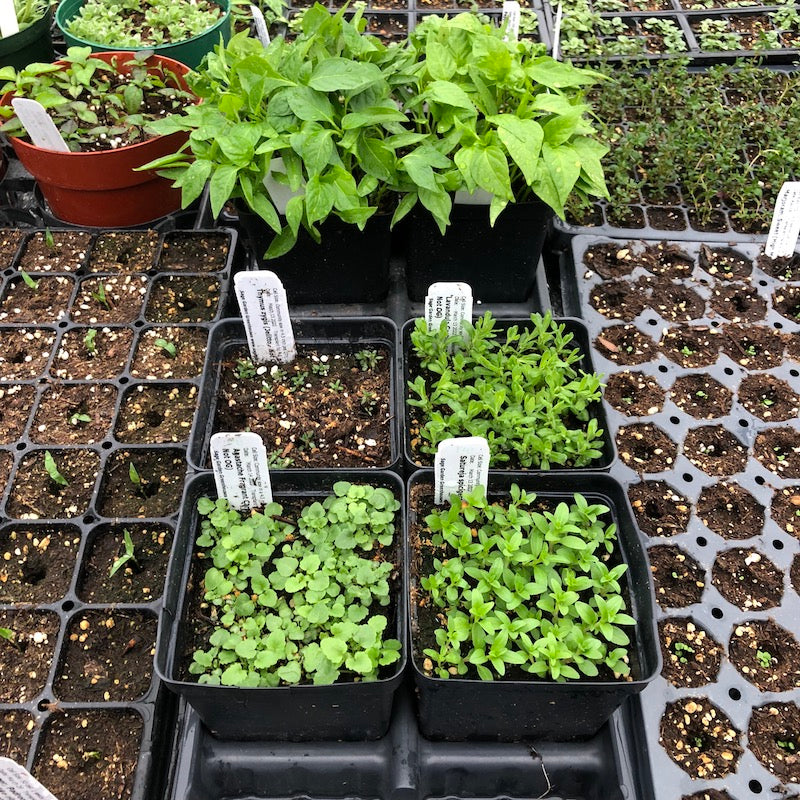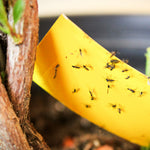As we are all busy seed-starting, I thought it may be helpful to discuss two opposing styles of planting: sowing into individual plug cells vs. sowing into a common pot, what I refer to as "community sowing". In many ways, it could be said that using plug trays is the more contemporary method while community seeding is old-school... but each of these techniques has important pros and cons. So, let's take a look.
Plug Seeding

Tuscany basil seedling plug. Plants with diffuse root systems and a tendency to do well in small clusters are very well suited to plug sowing (basil is ideally planted as 3-5 seeds together in one plug).
Plug trays are typically molded plastic liners with individual pockets into which seeds are sown. These come in many styles but most are designed to sit in the standard 1020 nursery flat, and feature between 32 and up to 288 individual cells. The higher the cell count the smaller each individual plug is.
The main advantage of plug trays is that each plant (or small cluster of plants) sown develops in a discrete space, allowing for easy removal from the tray when it comes time to transplant. Not only is this easier for the gardener, but it also takes some stress off the plant, as the roots are not disrupted when pulled from the tray. Some plug trays feature interesting innovations, such as simple channels on the sides that cause roots to grow long and straight as opposed to bound-up; another innovation is deep plug cells which take up the same amount of horizontal space but allow for plants that are much better established at transplant time.
There is no question that the use of plug trays dominates in propagation, but there are some downsides. The most significant is that they take up a lot of room under lights or in the greenhouse - and space is always something gardeners wish we had more of. Another disadvantage of plug trays is that depending on how quickly a particular seed germinates and develops, it can be hard to either keep the cells adequately watered or encourage appropriate drying out (fast-growing plants fill up the cells quickly and dry out fast; alow growing plants use up water slowly, and it is easy for the cells to remain too soggy).
Community Sowing

Spanish lavender seedlings community sown in a 4.5" deep pot
Before modern home and greenhouse products started being made from plastic there really was no such thing as a plug tray and therefore growers would sow into communal spaces that lacked individual cells. This is community sowing. Over time this technique became less common, replaced by plug trays, with the rationale that it damages seedlings to untangle the roots and separate the individual plants at transplant time. This is definitely sometimes true. However, MANY plants are very happy to grow together and easily come apart when the time comes. As such, this technique is making a comeback.
The top advantage of community sowing is that it saves space. In fact, a lot of space; and as previously mentioned this is worth its weight in gold for gardeners starting plants indoors or in a greenhouse.
Beyond space-saving, another interesting benefit of community sowing is that it seems to improve germination time and yields for some plants. I don't know why this occurs (perhaps something about soil moisture that is different in a larger pot, or possibly something at the plant hormone level when seeds co-mingle?) - but I have absolutely observed this firsthand in otherwise erratic germinators like ultra-hot peppers.
Among the most popular seeds for community sowing are hot peppers, eggplants, tomatoes, onions and their relatives, agastache, datura, lavender, yarrow, chamomile, and many types of houseplant seeds (which tend to be larger and germinate over a long period). This is a really brief list and many others are likely perfect for this type of sowing.
Further Considerations

Well developed community-sown hot pepper seedlings ready for transplant from a sturdy 4.5" plastic pot.
Whether planting into plastic plug cells or plastic community pots, it always pays to choose products that are sturdy and can be reused multiple times. Single-use plastics are a huge problem in horticulture as they cannot be recycled in municipal recycling streams, so being able to "reuse" is a high priority. Taking this one step further, the concept of both plug cells and community pots can be achieved using compostable containers; small wood fibre, coir or jiffy pots can replicate the idea of individual cells even if they are not joined and larger biodegradable pots are perfect for community sowing.

Another lesson I have learned is that even within a single genus there are some varieties or species that germinate more slowly or erratically compared to others that are related. So, it is worth experimenting and observing which ones work well in regular plug trays and which tend to waste space. In the photo above, the community pot has a wild type of thyme seedling from Portugal which rarely works nicely in plug trays (but is slow, steady and successful in community pots) and in the background are French thyme seedlings, which grow quickly and easily in plug trays.

I hope this discussion highlights an important concept in gardening: there is not a single way, and it often pays to experiment and evaluate where a particular strategy offers YOU the most benefit.
Happy planting... spring is young.







